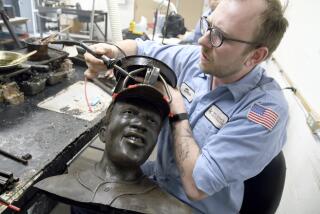A crack team tackles Venus
- Share via
ATLANTA — Conservators trying to restore a 1,900-year-old statue of Venus have put their heads together with airline maintenance inspectors who usually scrutinize welds and repairs in jet engines for cracks.
Officials at the Michael C. Carlos Museum at Emory University this summer bought the Roman marble statue and its head, which broke off sometime in the last 170 years.
Last week, they enlisted the help of Delta Air Lines inspectors at Hartsfield-Jackson Atlanta International Airport, who took X-rays of the statue and the head to try to determine where the statue had been broken before and how the old repairs were holding up.
Conservators will look for rusting metal pins that might have been inserted to fix cracks. Once they establish the condition of those repairs, which could date from antiquity to as recently as 200 years ago, they will know how best to put the 4-foot, 6-inch statue back together.
“I spend two-thirds of my time reversing other people’s good intentions,” museum conservator Renee Stein said jokingly of old repairs.
The statue, by an unknown artist, is a copy of a Greek bronze sculpture that many scholars say is the most widely reproduced female statue in antiquity. Although there are thousands of similar images of Venus in many sizes and materials, this restoration is significant because few statues are as large and nearly intact as this one, missing only the right arm.
“When statue pieces go down different roads, and they’re recognized, bought and put back together, it’s extremely noteworthy,” said Francesco de Angelis, an assistant professor of Roman art and archeology at Columbia University. “This type of statue was incredibly popular in antiquity.”
The museum bought the charmingly prudish sculpture of the goddess of love for $968,000 at a Sotheby’s auction in New York on June 6. A private collector in Houston agreed to sell the head to the buyer of the body, and the museum purchased it for about $50,000.
Delta inspectors, who also have worked with the museum on a vase and a statue, volunteered their time for the Venus.
“It’s a privilege for us to assist and help the Carlos bring this kind of history and art to our hometown of Atlanta,” said Delta spokeswoman Gina Laughlin.
The statue portrays Venus -- called Aphrodite by the Greeks -- caught off guard as she, having removed her clothes to take a bath, glimpses an unseen onlooker. She tries to cover herself with her hands, with a result more provocative than protective. A small figure of Eros rides a dolphin at her feet, a reference to the goddess’ birth from the sea.
The statue probably stood next to a fountain or pool in the gardens of a villa somewhere in the Roman Empire, possibly in today’s France. It was first documented in the collection of Napoleon’s art advisor in the 1830s, said Jasper Gaunt, curator of Greek and Roman art at the Carlos.
An 1836 engraving showed the statue intact, and it is not known how or when the head and arm broke off. The arm remains missing.
Venus is expected to strike her pose at the Carlos sometime in the spring.
More to Read
Sign up for Essential California
The most important California stories and recommendations in your inbox every morning.
You may occasionally receive promotional content from the Los Angeles Times.













